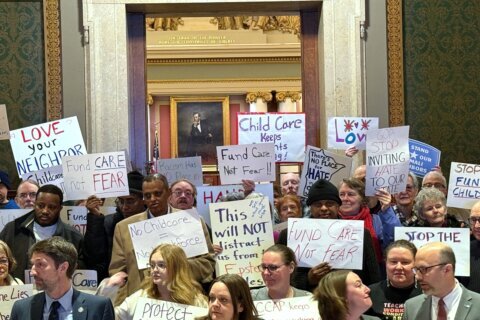When a child heads off to summer camp or to a beach house with friends, it’s common for parents to fret over sunscreen and manners — rarely is sexual abuse top of mind.
But it should be, said Michele Booth Cole, executive director of Safe Shores, a D.C.-based organization that works with, and advocates for, youth affected by trauma and violence.
In the U.S., one in 10 children will be sexually abused before the age of 18 — and that statistic is based on reported cases of abuse. Research shows more than 60% of child victims don’t disclose the fact that they have been sexually abused.
Cole said when kids go back to school in the fall, there’s always a spike in the number of child abuse cases reported, and it’s usually the ones that were missed during the less supervised summer months.
Safe Shores runs a number of free training programs in D.C. that teach adults how to prevent and recognize the signs of child abuse. Cole recently sat down with WTOP to share some advice for parents and caregivers to keep in mind this summer.
“If we, as adults, aren’t willing to be courageous and look this stuff in the eye, we’re just going to continue to place children at risk,” Cole said.
Start talking early and often
One of the best preventive measures parents can put in place is to establish an open and honest dialogue with their children — even as early as 18 months.
Cole said when you start teaching young ones about their body parts — their nose, eyes and ears — show them where their private parts are, and call those parts by the correct name. It may be uncomfortable at first, Cole said, but it’s important.
“If you’re comfortable with it, then there’s no shame in it for them,” Cole said.
“Language is power. When we equip children with language and we teach them the proper names for their body parts, then we’re starting to help them set boundaries because they’re going to know there are certain body parts that no one should touch. And if you’re not cloaking that in shame and discomfort, then they can come to you if anything should happen.”
If a child does come to you to discuss a sensitive matter, Cole said it’s important to listen “without judging.”
“Because if they feel like you’re judging then they’re going to shut down,” she said.
Remember: You are your child’s first source for information, so make sure the information that you’re giving them is accurate.
“It’s a very uncomfortable conversation for so many people. But if we’re not doing it — if we, as parents, aren’t having that conversation with our children — somebody else will, either on the internet, or kids on the playground at school, and generally, that is not going to be good information,” Cole said.
Know and identify situations that leave children at risk
Ninety percent of children are sexually abused by people they or their parents know, Cole said, so it’s important to identify the types of situations that can leave children at risk, and then work to find solutions that minimize that risk.
For example, seemingly innocent one-on-one adult/child situations, such as private music lessons or rides home from a coach leave a child open for danger. Cole said parents should have a plan for when those situations arise. If your child is riding alone with an adult, have the child sit in the back seat of the car, or have them call you on their way home.
“It’s not that we want to create a world where we don’t trust people, because we can’t live in that world. But [we need to use] tools, a framework to assess danger,” Cole said.
“It’s about: How do we minimize those situations, and if we can’t, what do we do to make them safer?”
Challenge institutions
Whether it’s summer camp or after-school programs you’re considering, don’t be afraid to ask questions on policies related to one-on-one adult interactions, such as taking a child inside to go to the bathroom during recess. Cole said institutions that work with children often have plans in place, and if they don’t, they should construct one.
“There are very simple things that we can do, but if we’re not thinking about them, if we’re not looking at situations with that lens, we’re not going to do it,” she added.
Remember: Abuse isn’t always obvious.
“The whole nature of, particularly child sexual abuse, is that it is kind of a hidden crime because the perpetrator works to make it hidden,” Cole said.
“They work to groom or manipulate the adults in the child’s life so that they have access to the child. And then, obviously, they work to cultivate a relationship of trust with that child so then they can do things with that child.”
Safe Shores offers the Stewards of Children training to teach adults how to prevent, recognize and react responsibly to child sexual abuse. Here are the next few dates:
Trainings at Safe Shores: 429 O Street, NW
- Tuesday, July 16, 5 to 7 p.m.
- Thursday, Aug. 22, 3 to 5 p.m.
- Wednesday, Sept. 18, 10 a.m. to noon
Training at Dorothy I. Height/Benning Neighborhood Library (Childcare provided)
- Saturday, Aug. 10, 11 a.m. to 1 p.m.
Spanish Training at Safe Shores: 429 O Street, NW
- Wednesday, Aug. 21, 5 to 7 p.m.
Spanish Training at Mt. Pleasant Neighborhood Library (Childcare provided)
- Saturday, July 6, 11:30 a.m. to 1:30 p.m.
Safe Shores also offers tours of its facility every other Thursday, from 8:30 to 9:30 a.m. More information is on the organization’s website.





